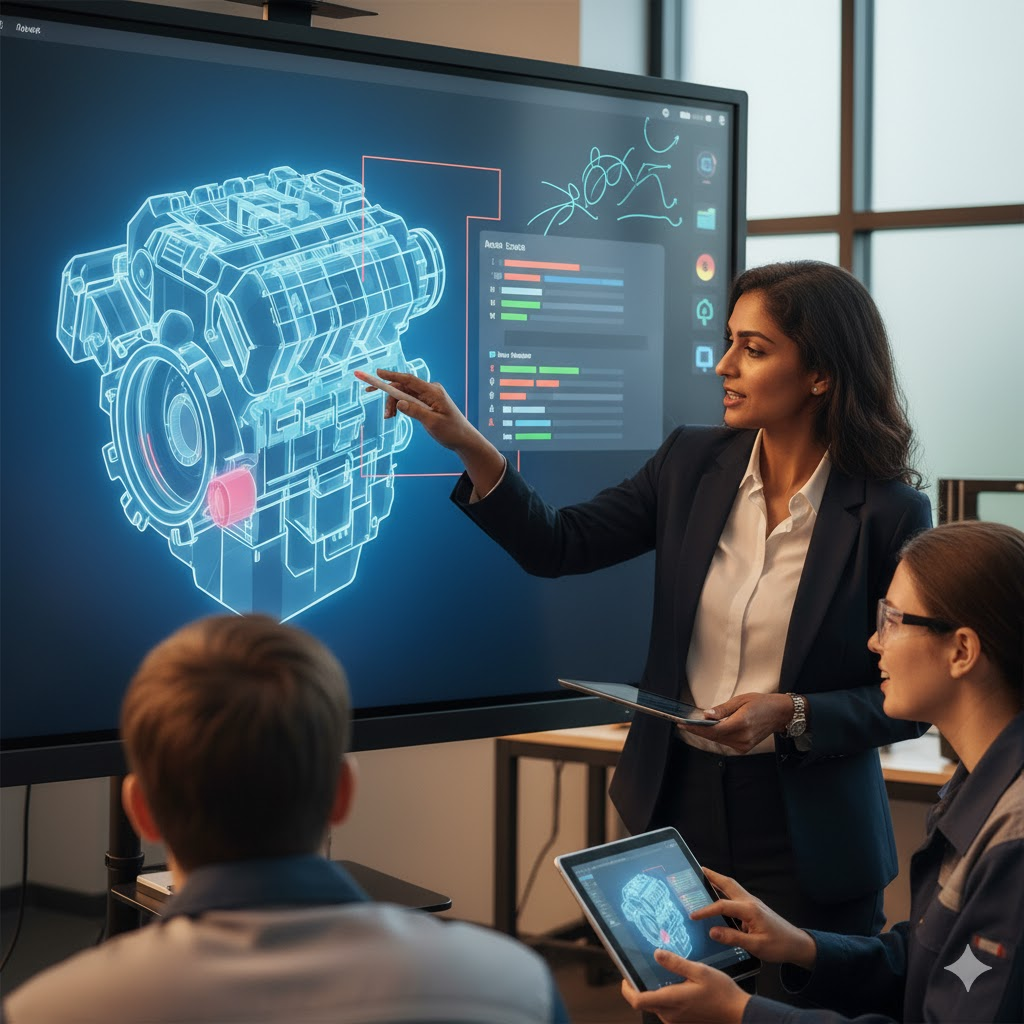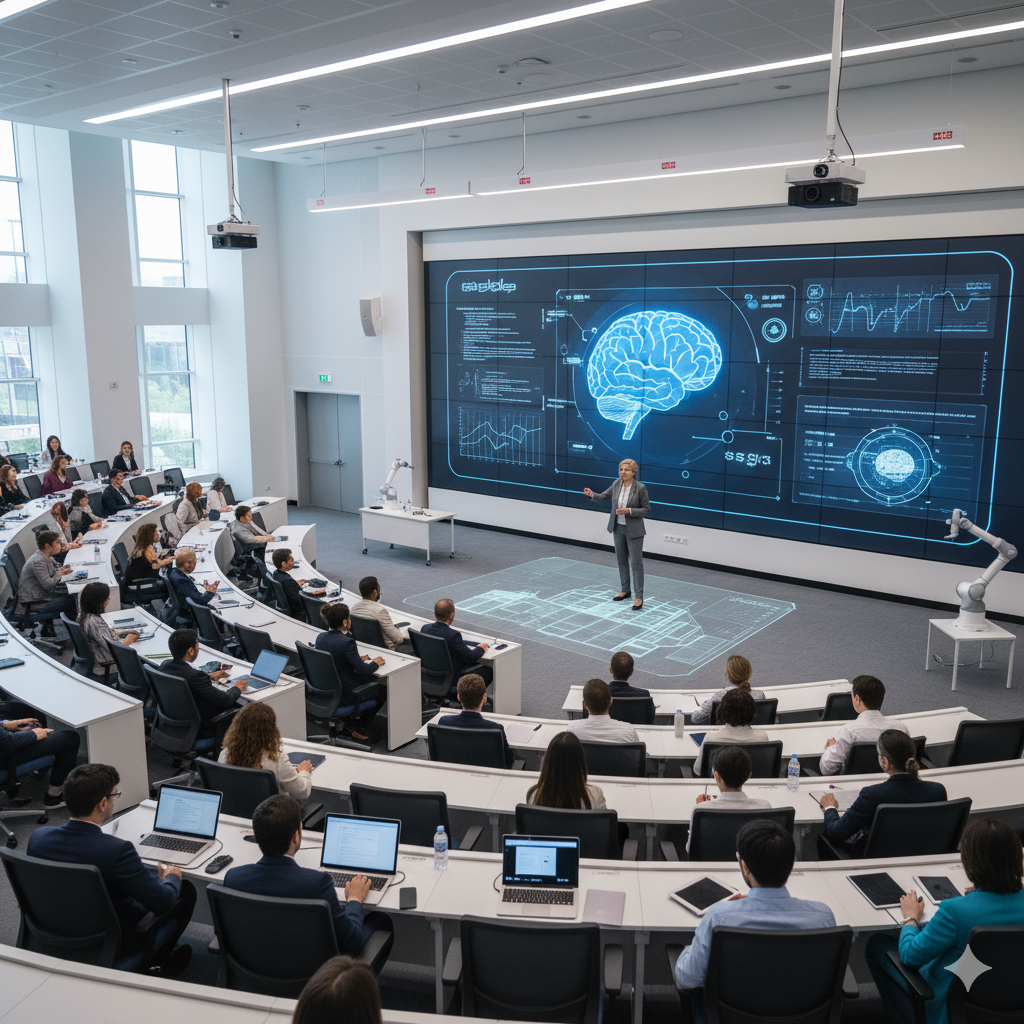How to Modernize Skill Training Institutes with a Digital Smart Classroom

Why 21st-Century Skills Demand 21st-Century Tools
Skill training institutes face a challenge that standard academic classrooms do not. You are tasked with teaching complex, tangible, hands-on skills from intricate automotive diagnostics and advanced coding to precise medical procedures.
The problem is that the traditional tools of education, static whiteboards, one-way lectures, and flat textbook diagrams, are fundamentally mismatched for this task. You cannot effectively demonstrate a 3D engine schematic, a dynamic software workflow, or a collaborative design process on a simple chalkboard. This is the gap where student engagement is lost and the transfer of practical knowledge fails.
Today, modernization is a necessity. The solution is the digital smart classroom, an integrated ecosystem of hardware and software designed for interaction, collaboration, and high-impact visual learning.
This guide is not a technical manual. It is a 5-step strategic framework to help you plan and implement a digital classroom setup that directly serves the practical needs of your instructors and students.
5 Steps to Create a Digital Smart Classroom for Skills Training
Step 1: Start with Pedagogy, Not Technology
The most common failure point in modernization is buying technology for its own sake. A successful implementation begins by analyzing how you teach and what your students need to learn. Before you review a single product spec, you must define your "why."
Ask these critical questions:
- What is our core curriculum? The needs of a culinary arts program (requiring high-def video and close-ups) are different from a coding bootcamp (requiring seamless screen sharing and collaboration tools).
- What are our instructors' biggest hurdles? Do they struggle to show fine detail? Do they spend too much time re-drawing complex diagrams? Is it difficult to manage a hybrid class with both remote and in-person students?
- What does a "job-ready" graduate need to know? If they will be using diagnostic tablets and digital interfaces in the field, their training environment should reflect that.
Your answers will create a "needs-based" blueprint. This ensures every piece of smart classroom equipment you purchase is a direct solution to a specific teaching problem.
Step 2: Define Your Core Smart Classroom Equipment

With your "why" established, you can build your "what." A digital smart classroom is a system. Here are the core components for a skill-based training center.
The Centerpiece: The Interactive Flat Panel (IFP) Solution
This is the replacement for your traditional whiteboard and projector, and it is the heart of the modern classroom. An all-in-one interactive flat panel solution is essentially a large, powerful, touchscreen computer.
For a skill institute, its value is immediate:
- Dynamic Visualization: Instructors can pull up 3D models, rotate them, and zoom in to show a specific part.
- Real-Time Annotation: They can pause a video of a technical procedure, draw directly on the screen to highlight a critical step, and save the notes.
- Digital Whiteboarding: They can co-create flowcharts, annotate code, or brainstorm on an infinite canvas, then instantly save and email the session to all students.
High-Clarity Audio and Video
If hybrid learning is part of your plan, audio and video are essential.
- Intelligent Camera: A high-definition, auto-tracking camera that follows the instructor as they move or can be zoomed in on a physical demonstration.
- Quality Microphones: Clear audio is more critical than clear video. Intergrated microphones ensure remote students can engage in discussions, not just passively watch.
Connectivity and Software
The "smart" in the digital smart classroom is its connectivity.
- Wireless Screen Sharing: The ability for both instructors and students to share their device screens to the main IFP with a single click. This is non-negotiable for teaching software, code, or design.
- Learning Management System (LMS) Integration: The classroom technology should seamlessly work with your existing LMS to pull up course materials, assignments, and resources.
Step 3: Design the Digital Classroom Setup for Interaction
The old layout of static desks facing a single point is designed for passive consumption. A modern training room must be designed for active interaction. Your digital classroom setup should be flexible.
- Create Collaborative Hubs: Use movable tables and chairs that can be easily reconfigured into "pods" for group work. This allows students to collaborate on a problem and then share their findings on the main interactive screen.
- Prioritize Workflow: Consider how the instructor and students will use the space. The IFP should be the focal point, but there should be clear paths for the instructor to move and engage with student groups.
- Integrate Hybrid Learners: Position your camera and microphones so remote students feel like participants, not spectators. The screen facing the instructor can display the remote students, making eye contact and engagement natural.
Step 4: Prioritize Faculty Adoption and Training
You can install the most advanced equipment in the world, but it is useless if your instructors are intimidated by it or don't know how to integrate it.
A common failure point is investing in the hardware but not the people.
- Focus on the "WIIFM": Your training should focus on "What's In It For Me?" for the instructors. Show them how the new digital smart classroom solves their specific frustrations—no more projector bulb-outs, no more lost notes, no more barriers to showing a complex video.
- Go Beyond the "How-To": Don't just teach what the buttons do. Teach how to build a more engaging lesson plan with the tools. How can they use the IFP display to create a more interactive skills test?
- Build Internal Champions: Identify a few tech-savvy instructors and give them advanced training. They will become your on-site mentors who can encourage and assist their peers, driving adoption from the ground up.
Step 5: Establish Metrics and an Iteration Loop
Modernization is not a "set it and forget it" project. It's a continuous improvement cycle. You must have a plan to measure your success and iterate.
- Gather Qualitative Feedback: Actively survey your instructors and students. Is the technology intuitive? Is it making classes more engaging? What features are most/least valuable?
- Track Quantitative Data: Look for tangible changes in outcomes. Are students' comprehension rates on complex topics improving? Are pass rates on certification exams going up? Is student engagement (e.g., participation, attendance) higher?
Use this data to make informed decisions. You may find you need to invest in a different software, offer more training on a specific feature, or upgrade the audio in a particular room. This loop of feedback and iteration ensures your investment continues to pay dividends long after the initial installation.
Final Thoughts
Modernizing your skill training institute is a strategic shift from passive information delivery to active, hands-on learning.
By thoughtfully implementing a digital smart classroom, you are creating an environment that mirrors the modern workplace. You are giving your instructors the tools they need to teach complex skills effectively, and you are giving your students the engaging, high-impact learning experience they need to succeed in their careers.
This 5-step process provides a clear path to building a learning environment that is as dynamic and advanced as the skills you teach.
Ready to see what a truly modern training environment looks like? Explore Roombr's all-in-one digital smart classroom solutions and see the tech in action.
Foziya Abuwala
Share
Step Into the future of
Education with Roombr

















